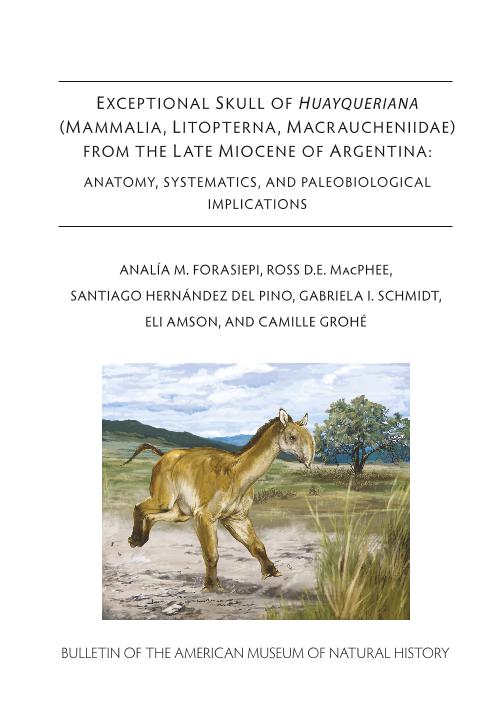Artículo
Exceptional skull of huayqueriana (mammalia, litopterna, macraucheniidae) from the late miocene of Argentina: Anatomy, systematics, and peleobiological implications
Forasiepi, Analia Marta ; MacPhee, Ross D. E.; Hernández del Pino, Santiago Ezequiel
; MacPhee, Ross D. E.; Hernández del Pino, Santiago Ezequiel ; Schmidt, Gabriela Ines
; Schmidt, Gabriela Ines ; Amson, Eli; Grohé, Camille
; Amson, Eli; Grohé, Camille
 ; MacPhee, Ross D. E.; Hernández del Pino, Santiago Ezequiel
; MacPhee, Ross D. E.; Hernández del Pino, Santiago Ezequiel ; Schmidt, Gabriela Ines
; Schmidt, Gabriela Ines ; Amson, Eli; Grohé, Camille
; Amson, Eli; Grohé, Camille
Fecha de publicación:
06/2016
Editorial:
American Museum Natural History
Revista:
Bulletin of the American Museum of Natural History
ISSN:
0003-0090
Idioma:
Inglés
Tipo de recurso:
Artículo publicado
Clasificación temática:
Resumen
The Huayquerías Formation (Late Miocene, Huayquerian SALMA) is broadly exposed in westcentral Argentina (Mendoza). The target of several major paleontological expeditions in the first half of the 20th century, the Mendozan Huayquerías (badlands) have recently yielded a significant number of new fossil finds. In this contribution we describe a complete skull (IANIGLA-PV 29) and place it systematically as Huayqueriana cf. H. cristata (Rovereto, 1914) (Litopterna, Macraucheniidae). The specimen shares some nonexclusive features with H. cristata (similar size, rostral border of the orbit almost level with distal border of M3, convergence of maxillary bones at the level of the P3/P4 embrasure, flat snout, very protruding orbits, round outline of premaxillary area in palatal view, and small diastemata between I3/C and C/P1). Other differences (e.g., lack of sagittal crest) may or may not represent intraspecific variation. In addition to other features described here, endocast reconstruction utilizing computer tomography (CT) revealed the presence of a derived position of the orbitotemporal canal running below the rhinal fissure along the lateroventral aspect of the piriform lobe. CT scanning also established that the maxillary nerve (CN V2) leaves the skull through the sphenoorbital fissure, as in all other litopterns, a point previously contested for macraucheniids. The angle between the lateral semicircular canal and the plane of the base of the skull is about 26°, indicating that in life the head was oriented much as in modern horses. Depending on the variables used, estimates of the body mass of IANIGLA-PV 29 produced somewhat conflicting results. Our preferred body mass estimate is 250 kg, based on the centroid size of 36 3D cranial landmarks and accompanying low prediction error. The advanced degree of tooth wear in IANIGLA-PV 29 implies that the individual died well into old age. However, a count of cementum lines on the sectioned left M2 is consistent with an age at death of 10 or 11 years, younger than expected given its body mass. This suggests that the animal had a very abrasive diet. Phylogenetic analysis failed to resolve the position of IANIGLA-PV 29 satisfactorily, a result possibly influenced by intraspecific variation. There is no decisive evidence for the proposition that Huayqueriana, or any other litoptern, were foregut fermenters.
Palabras clave:
South American Native Ungulates
,
Litopterna
,
Macraucheniinae
,
Cenozoic
Archivos asociados
Licencia
Identificadores
Colecciones
Articulos(CICYTTP)
Articulos de CENTRO DE INV.CIENT.Y TRANSFERENCIA TEC A LA PROD
Articulos de CENTRO DE INV.CIENT.Y TRANSFERENCIA TEC A LA PROD
Articulos(IANIGLA)
Articulos de INST. ARG. DE NIVOLOGIA, GLACIOLOGIA Y CS. AMBIENT
Articulos de INST. ARG. DE NIVOLOGIA, GLACIOLOGIA Y CS. AMBIENT
Citación
Forasiepi, Analia Marta; MacPhee, Ross D. E.; Hernández del Pino, Santiago Ezequiel; Schmidt, Gabriela Ines; Amson, Eli; et al.; Exceptional skull of huayqueriana (mammalia, litopterna, macraucheniidae) from the late miocene of Argentina: Anatomy, systematics, and peleobiological implications; American Museum Natural History; Bulletin of the American Museum of Natural History; 404; 6-2016; 1-76
Compartir



